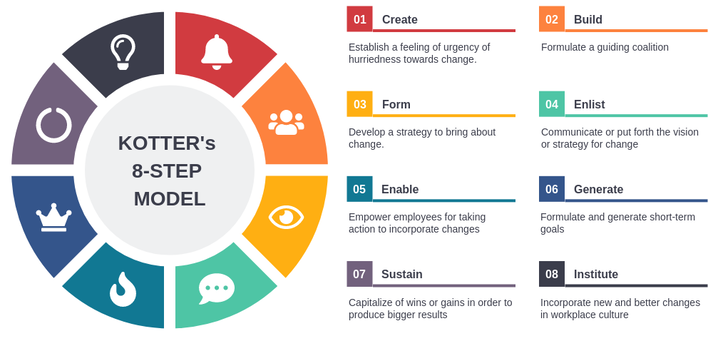 Kotter's 8-Step Change Model Kotter's 8-Step Change Model by: Scott E McGlon In today's fast-paced and competitive business landscape, successful execution hinges on effective strategic planning and implementation. To navigate this complex environment, organizations rely on a myriad of business tools and frameworks. This comprehensive guide explores the utilization of essential tools such as OKRs, KPIs, Balanced Scorecard, Ansoff Matrix, BCG Matrix, and the Blue Ocean Strategy to generate, evaluate, and execute strategic options. Additionally, we dive into communication plans, implementation management, and post-implementation evaluation strategies. All three sections are critical to define, and ultimately achieve, optimal results. Whether you are a startup or an established company, these tools and techniques are invaluable for achieving your strategic objectives. In each section below, we have provided, what we think, is the most appropriate and thorough link for each business tool and frameworks. This will give you the ability to dive into each business tool outlined to get a clear perspective on how they can impact your business in the most optimal way. Section 1: Setting the Strategic Foundation 1.1 Objectives and Key Results (OKRs) OKRs provide a goal-setting framework that aligns everyone in the organization with the company's strategic objectives. They consist of clear, measurable objectives and key results that measure progress toward those objectives. OKRs help organizations define their priorities, track performance, and foster accountability. 1.2 Key Performance Indicators (KPIs) KPIs are quantifiable metrics that measure the success of various aspects of a business. They serve as crucial benchmarks for tracking progress, identifying areas for improvement, and ensuring that strategic goals are met. Choosing the right KPIs is essential for effective performance management. 1.3 Balanced Scorecard The Balanced Scorecard is a comprehensive framework that translates an organization's mission and strategy into a set of performance measurements. It helps businesses balance financial and non-financial indicators, providing a holistic view of performance across four perspectives: financial, customer, internal processes, and learning and growth. Section 2: Generating Strategic Options 2.1 Ansoff Matrix The Ansoff Matrix is a tool that assists in exploring growth strategies. It presents four growth options: market penetration, market development, product development, and diversification. By analyzing these options, businesses can identify the most suitable growth strategy for their current situation. 2.2 Boston Consulting Group Matrix (BCG Matrix) The BCG Matrix categorizes a company's products or business units into four quadrants: stars, question marks, cash cows, and dogs. This matrix helps organizations allocate resources effectively by focusing on products or units with the highest growth potential and market share. 2.3 Blue Ocean Strategy The Blue Ocean Strategy challenges traditional competition-based strategies by encouraging businesses to create uncontested market spaces (blue oceans) rather than competing in saturated markets (red oceans). It involves innovation and value creation to make competition irrelevant. Section 3: Implementation and Communication 3.1 Establishing a Strong Communication Plan Effective communication is essential during strategy implementation. Tools like Gantt Charts, RACI Matrices, and Kanban Boards help teams communicate tasks, responsibilities, timelines, and progress effectively.
Section 4: Evaluating Results and Outcomes 4.1 Strategic Planning Framework for Evaluation Evaluating the results and outcomes of strategy implementation is critical for continuous improvement. Use tools like dashboards, scorecards, and After-Action Reviews (AARs) to assess performance and gather insights.
Section 5: Additional Strategies for Startups and Established Companies For startups:
In conclusion, effective strategic planning, implementation, and evaluation are paramount for long-term success with any business. Leveraging a comprehensive toolkit of business tools such as OKRs, KPIs, Balanced Scorecard, Ansoff Matrix, BCG Matrix, and the Blue Ocean Strategy provides organizations with the means to navigate uncertainty, make informed decisions, and achieve strategic goals. By complementing these tools with robust communication plans and post-implementation evaluation strategies, businesses can adapt to changing landscapes, drive new innovations, and continuously improve their performance, regardless of their stage of development. What Peter Drucker said decades ago certainly applies for every business operating today: What gets measured, gets managed! About the Author: Scott E McGlon is the President of McGlon Properties, LLC and the author of many blog post on MP Blog. He has been a serial entrepreneur, investor, and president of many successful start-ups since 1998.
0 Comments
Leave a Reply. |
Multiple AuthorsMP, LLC credits blog post with the original author and links (if available). Categories
All
AuthorScott E McGlon is the President of McGlon Properties, LLC and the author of many blog posts on MP Blog. He has been a serial entrepreneur, entrepreneur-in-residence, investor, and president/CEO of many successful start-ups since 1998. “Success is walking from failure to failure with no loss of enthusiasm." - Winston Churchill "The few who actually
go out and take extraordinary initiatives are the envy of the majority who sit back and just observe." “The LORD makes firm the steps of the one who delights in Him; though he may stumble, he will not fall, for the LORD upholds him with His hand.” - Psalm 37:23-24
“Keep away from people who try to belittle your ambitions. Small people always do that, but the really great people make you feel that you, too, can become great.” "It is more important in what you become than what you achieve. What are you going to become in pursuit of what you want?" - John Marsh, Marsh Collective
“Work harder on yourself than you do on your job" - Jim Rohn
"The secret to success is very simple: EVERYDAY if you do quality work, take initiative, act on innovative thoughts, and are assertive in your actions all backed by faith, the dividends will consistently flow your way." - SEM
|
Real Estate Properties | Business Blog | Our Ethos | Press Releases | TENANTS ONLY | Contact Us
Terms & Conditions | Privacy Policy | Gameday Condos Auburn AL All rights reserved. Auburn Football Memorabilia
Corporate Offices: McGlon Properties, LLC - Auburn Alabama - [email protected]
Corporate Offices: McGlon Properties, LLC - Auburn Alabama - [email protected]


 RSS Feed
RSS Feed